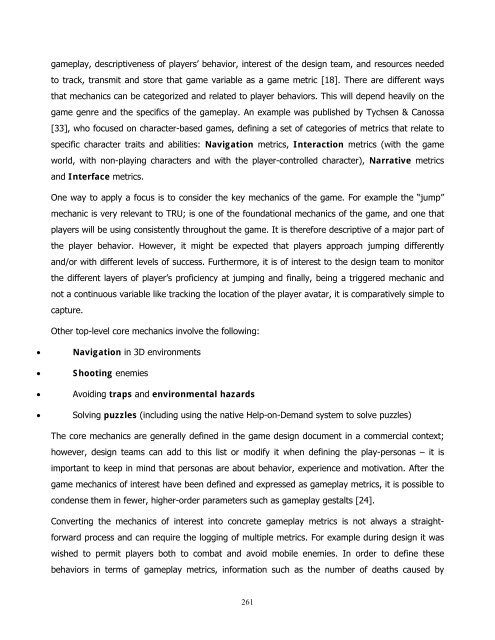Play-Persona: Modeling Player Behaviour in Computer Games
Play-Persona: Modeling Player Behaviour in Computer Games
Play-Persona: Modeling Player Behaviour in Computer Games
You also want an ePaper? Increase the reach of your titles
YUMPU automatically turns print PDFs into web optimized ePapers that Google loves.
gameplay, descriptiveness of players’ behavior, <strong>in</strong>terest of the design team, and resources needed<br />
to track, transmit and store that game variable as a game metric [18]. There are different ways<br />
that mechanics can be categorized and related to player behaviors. This will depend heavily on the<br />
game genre and the specifics of the gameplay. An example was published by Tychsen & Canossa<br />
[33], who focused on character-based games, def<strong>in</strong><strong>in</strong>g a set of categories of metrics that relate to<br />
specific character traits and abilities: Navigation metrics, Interaction metrics (with the game<br />
world, with non-play<strong>in</strong>g characters and with the player-controlled character), Narrative metrics<br />
and Interface metrics.<br />
One way to apply a focus is to consider the key mechanics of the game. For example the “jump”<br />
mechanic is very relevant to TRU; is one of the foundational mechanics of the game, and one that<br />
players will be us<strong>in</strong>g consistently throughout the game. It is therefore descriptive of a major part of<br />
the player behavior. However, it might be expected that players approach jump<strong>in</strong>g differently<br />
and/or with different levels of success. Furthermore, it is of <strong>in</strong>terest to the design team to monitor<br />
the different layers of player’s proficiency at jump<strong>in</strong>g and f<strong>in</strong>ally, be<strong>in</strong>g a triggered mechanic and<br />
not a cont<strong>in</strong>uous variable like track<strong>in</strong>g the location of the player avatar, it is comparatively simple to<br />
capture.<br />
Other top-level core mechanics <strong>in</strong>volve the follow<strong>in</strong>g:<br />
• Navigation <strong>in</strong> 3D environments<br />
• Shoot<strong>in</strong>g enemies<br />
• Avoid<strong>in</strong>g traps and environmental hazards<br />
• Solv<strong>in</strong>g puzzles (<strong>in</strong>clud<strong>in</strong>g us<strong>in</strong>g the native Help-on-Demand system to solve puzzles)<br />
The core mechanics are generally def<strong>in</strong>ed <strong>in</strong> the game design document <strong>in</strong> a commercial context;<br />
however, design teams can add to this list or modify it when def<strong>in</strong><strong>in</strong>g the play-personas – it is<br />
important to keep <strong>in</strong> m<strong>in</strong>d that personas are about behavior, experience and motivation. After the<br />
game mechanics of <strong>in</strong>terest have been def<strong>in</strong>ed and expressed as gameplay metrics, it is possible to<br />
condense them <strong>in</strong> fewer, higher-order parameters such as gameplay gestalts [24].<br />
Convert<strong>in</strong>g the mechanics of <strong>in</strong>terest <strong>in</strong>to concrete gameplay metrics is not always a straightforward<br />
process and can require the logg<strong>in</strong>g of multiple metrics. For example dur<strong>in</strong>g design it was<br />
wished to permit players both to combat and avoid mobile enemies. In order to def<strong>in</strong>e these<br />
behaviors <strong>in</strong> terms of gameplay metrics, <strong>in</strong>formation such as the number of deaths caused by<br />
261















